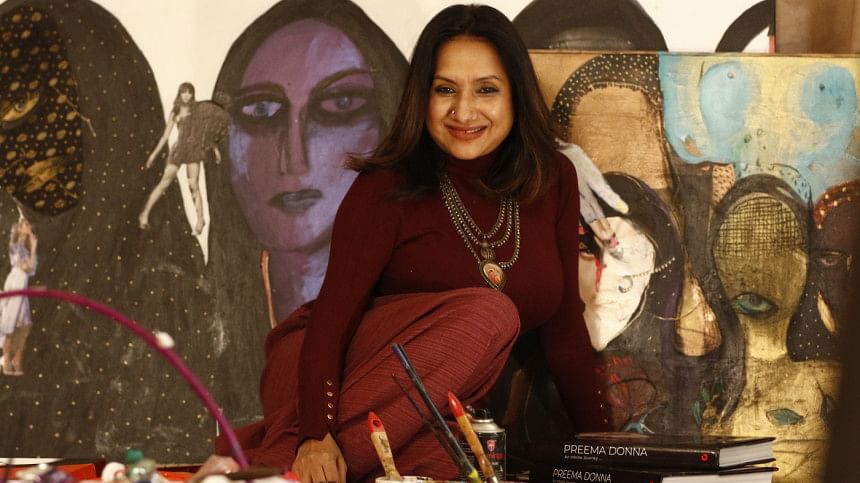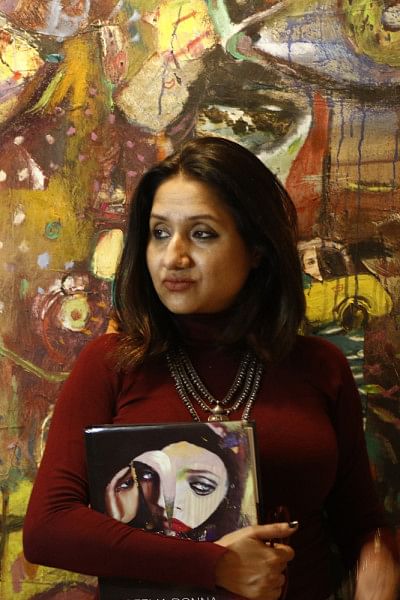‘Preema Donna’: What is art?

I met with Bangladeshi artist Preema Nazia Andaleeb at Liverpool Street rail station, London, in December of 2022. We walked and talked about life, philosophy and her art. We settled in a venue in Finsbury Square, near the station, to continue our conversation.
While there, Preema presented me with a copy of her book, "Preema Donna: an infinite journey".
'Prima donna' is literally the 'first lady'. The term originates from Italian opera. Donna can also mean queen. Preema Donna becomes a play on 'Prima Donna'.
In the preface of her book, the artist mentions, "Art is a question to me, not an answer. Hence, as an artist I am always alive, like art, travelling from soul to soul."

For Preema Nazia Andaleeb there is no such notion as Leo Tolstoy's 'What is art' (Russia 1897). All materials, and any material, may be conscripted to her purpose of art-making, including performance art, using her dancing and performing skills.
Her, and art's, purpose is to communicate the essence and urgency of communication, and in whichever way her intrinsic purpose demands. Notions of flatness vs dimensionality, width, height, length, breadth, time, medium become utilised in her works. Often, the medium becomes not just the conveyor of the message, but frequently the message itself.
Like many artists Preema Nazia Andaleeb does not limit herself to one singular mode of expression. Instead, she organises photographic elements, paints in oils and acrylics, creates with digital media, performs modern choreographic movements with intimations of the traditional Indian dances—such as the Tamil classical dance Bharatanatyam, she has studied—to illustrate body and gender politics and generally to aid greater knowledge of the plight of women in misogynistic relationships and cultures, utilising a vast array of mediums when and where she deems appropriate.
Within Preema Nazia Andaleeb's book there are reminders of that indigeneity in Jamini Roy's work in her paintings such as 'Women of Abstraction 10', 'Beyond Identity: The Sum of her Parts' and an earlier work 'Haunted Existence'. It's the large almond shaped eyes. They are remnants of a Bengali folk tradition coupled with the darkened ferocity of Rabindranath Tagore's paintings of women. Like Roy and Tagore, Preema—in her paintings of women—situates herself within 'Modern' Indian, but more especially Bengali, roots and their modernist re-interpretation of folk art, rather than exhibiting any overt Western intimations.
Prima Donna she may be, but Preema Nazia Andaleeb does not 'act out'. She 'talks out'. She is a woman who firmly grasps the baton of female suppression and re-creates within the sphere of concepts concerning the subordination of women.

Notions of the 'subaltern'. Preema Nazia Andaleeb subverts the traditional muted role of the mythic Radha (beloved of Krishna), from the ancient Hindu Radha/Krishna story of the humble gopi (milkmaid) who became the beloved of the god Krishna. Preema Nazia Andaleeb brings Radha into modernity.
In her chapter 'Concept of Modern Radha', Preema Nazia Andaleeb de-veils Radha, de-mystifies and dis-entangles her from subaltern entrapment. Radha is seen as a woman.
The next chapter in 'Preema Donna' is, fittingly, 'Cosmopolitan Women', in which the artist makes good use of a variety of art-making techniques to present the diversity of women within the Asian diaspora, as 'women of the world'. The painting 'Cosmopolitan Women' is, poignantly, a mixed media piece used as the front cover of the artist's book 'Preema Donna', and its slipcover. We see oblique references to the fashion magazine 'Cosmopolitan', its Western style and glamour, with photographic cut-out images. These become contrasted with images of women with hijab (hair covering), and some niqab (a veil that covers the face, but leave the eye area uncovered) while others wear the burqa (a female full body covering), none of which are technically compulsory in Bangladesh.
There is the bleak contrast between what one woman might wear irrespective of religious affiliations, and the raiments available to some choosing to wear for religious reasons, willingly or unwillingly.
Unspoken are the words 'slave to fashion' and the anomaly of being free and yet a slave to fashion trends. However, the very real enslavement continues in Bangladesh's sweatshops, where workers are paid a pittance to produce garments for brand-named companies, to sell to followers of fashion. As East Bengal, the link to Western fashion and the dye colour indigo runs deeper into issues of Colonialism, the Raj, and indigo farmers' riots.
While there are differences of opinion as to whether 'Performance Art' is art, Preema Nazia Andaleeb has continued to engage in aspects of 'performance, since young.
Preema Nazia Andaleeb, while provocative in her presentations and performances, shocks in ways that do not require the phallic presence of a gun. She uses the presence of mind and the female body as seen in her book, "Preema Donna". There, she reveals that 'woman' does not now need to counter the "language only that which speaks in the masculine" to overcome notions of transgression and the fears of Hélène Cixous, and Gayatri Spivak's concerns. Instead, she becomes free.

 For all latest news, follow The Daily Star's Google News channel.
For all latest news, follow The Daily Star's Google News channel. 



Comments